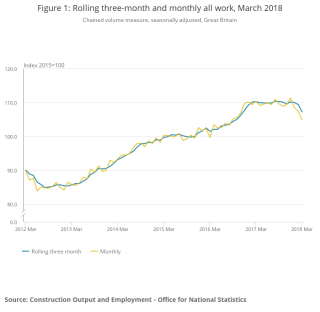The three-month on three-month decrease in construction output was driven by falls in both repair and maintenance, and new work, which fell 2.8% and 2.6% respectively.
Construction output also fell month-on-month, contracting by 2.3% in March 2018 compared to February.
The Office for National Statistics (ONS) acknowledge reports from some survey respondents that their businesses had been affected by bad weather in February and March 2018 but said it was “difficult to quantify the exact impact on the industry”.
The estimate for construction growth in 2018 Q1 has been revised up 0.6 percentage points to minus 2.7%, from minus 3.3% that it previously used in the preliminary estimate of gross domestic product (GDP). The adjustment is too small to impact on GDP figures though.
ONS says that, following consecutive periods of month-on-month growth, construction output reached a record high in the final two months of 2017 before falling back again. Construction output’s peak in December 2017 was 30.3% higher than the lowest point of the last five years, April 2013. Despite the decrease in 2018, construction output remains 22.7% above this nadir.

Rebecca Larkin, senior economist at the Construction Products Association, said: “This release confirms what was reported in preliminary GDP data: construction had a poor opener to 2018. The 2.7% contraction in output was revised up from the initial estimate of a 3.3% decline, but this still represents the weakest outturn since August 2012 and a £1.04 billion loss in output in three months.
“Output declined in each month of the quarter, undoubtedly capturing the pauses in work relating to Carillion’s liquidation in January and the snow disruption in February and March. Notably, private housing lost its position as the industry’s star performer, with output falling from a record high, but activity is expected to accelerate as we enter the spring selling season.”
Blane Perrotton, managing director of the property consultant Naismiths, commented: “After months of playing a bad hand well, the construction industry has lost its trump card. Housebuilding was more than just the one bright spot against the increasingly dark backdrop – it had taken on a totemic importance as a beacon of demand, resilience and hope. Without it, the sector looks dangerously exposed. Not for nothing is construction is now suffering the highest number of new insolvencies of any industry.
“The slump in output is the worst for six years, as the industry has been hit for six by a toxic combination of weak confidence, softening investor demand and rising input costs. Despite the low interest rate environment and abundance of finance available, developers are increasingly doubling down – concentrating on completing existing projects rather than commissioning new ones.
“Nevertheless it’s wrong to draw parallels with the painful slowdown seen at the start of the decade. For all the fall in demand, access to finance has never been better and order books remain strong outside London. Yet at this rate there is likely to be more pain to come, as there is little sign of an end to the limbo which is prompting investors in London and the southeast to sit on their hands.”
Got a story? Email news@theconstructionindex.co.uk




